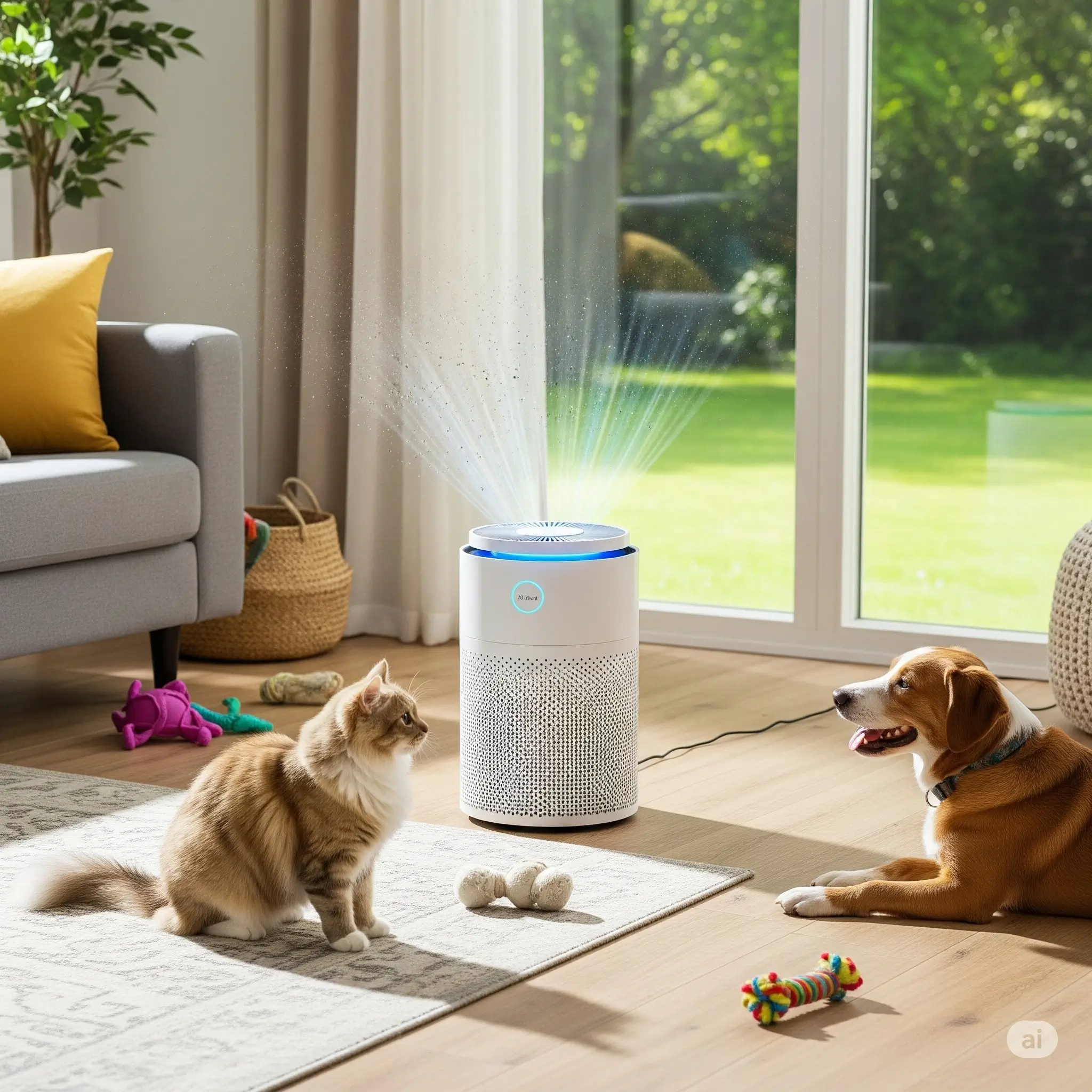Ever walked into your house and been hit with a smell you just can’t shake? Maybe it’s last night’s dinner, your dog’s favorite spot on the couch, or that weird musty scent from the basement. Air purifiers are often recommended for clearing out these kinds of odors, but do air purifiers help with smell, really?
In this article, we’ll break down how air purifiers tackle odors, what types of smells they can actually remove, and what you should know before buying one. We’ll also go through some of the best models for odor control and talk about what air purifiers can’t do, so you know what to expect.
Key Takeaways
- Air purifiers can help reduce indoor smells, but their success depends on the type of filter activated carbon is key for odor removal.
- HEPA filters are great for dust and allergens but aren’t very effective against most smells; you’ll want a purifier with a good carbon filter for odors.
- Air purifiers perform best on common household smells like cooking, animal companions, smoke, and musty rooms, but some tough odors may linger without other cleaning methods.
- Proper maintenance, like changing filters on time and placing the unit in the right spot, is important for getting rid of smells.
Not all air purifiers are equal, choose one that matches your room size and odor problem, and remember that ozone generators are not safe for regular home use.
Understanding How Air Purifiers Address Odours
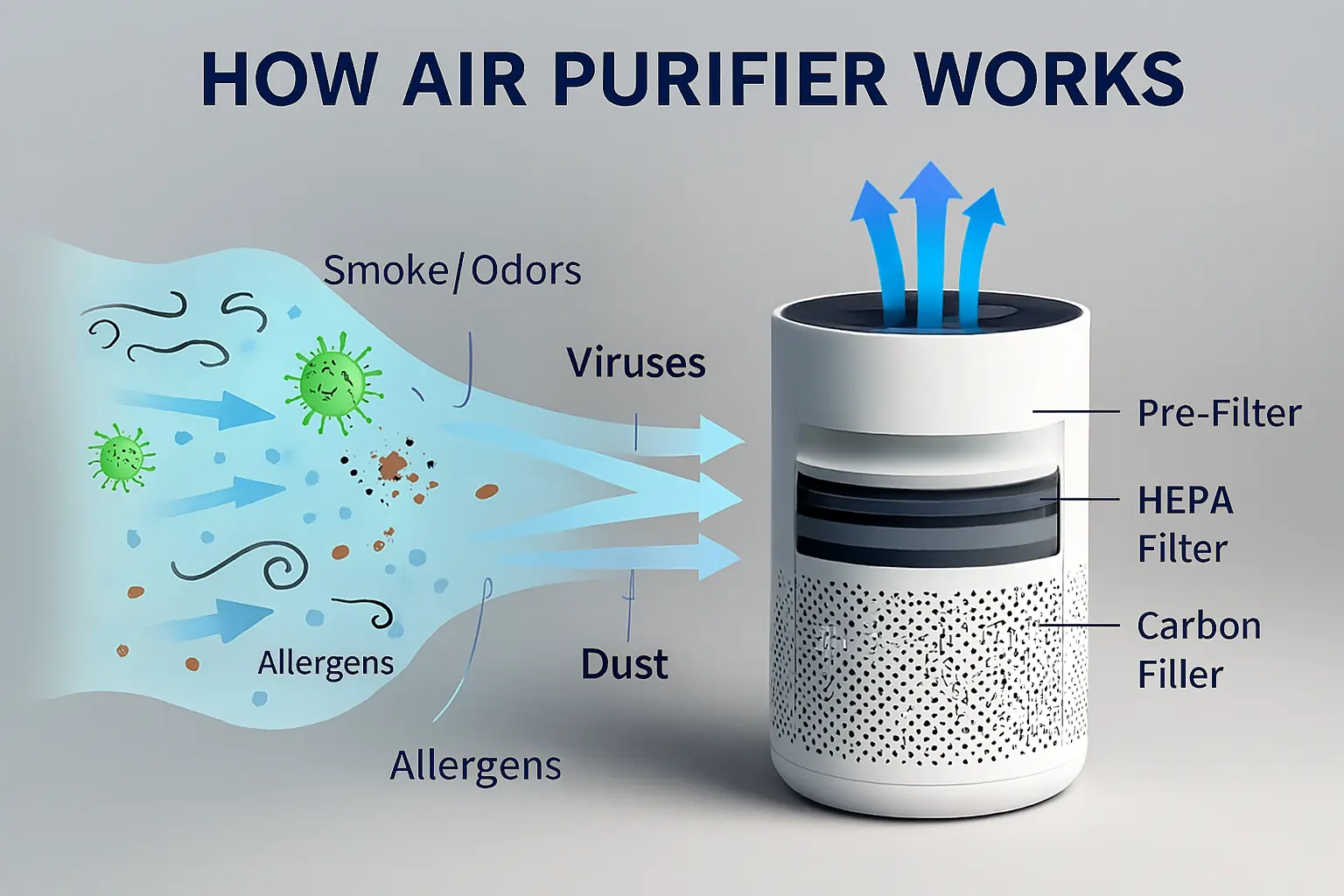
Why Smells Linger Indoors
Most indoor odors stick around longer than we’d like. That’s because homes are full of soft surfaces like carpets, curtains, and furniture. These materials tend to trap gaseous compounds and moisture, making them a sort of holding area for unwanted smells. Even after opening a window or cleaning up, the smell might come back as these surfaces slowly release odor molecules back into the air.
- Carpets absorb spills and odors from pets or food.
- Upholstered furniture clings to smoke and strong meal scents.
- Humidity (think bathrooms or kitchens) can make musty and moldy odors harder to shake.
If your house has persistent smells, nine times out of ten they’re not just hanging in the air they’re buried deep in the fabrics and dust.
The Role of Filtration in Odor Removal
When you turn on an air purifier, you’re counting on the filters to trap whatever’s making your home smell off. HEPA filters are fantastic for catching fine particles like dust, pollen, or pet dander, but they don’t do much about most odor causing gases. For actual odor removal, you need more than one type of filtration functioning together:
| Filter type | What it removes |
|---|---|
| HEPA | Dust, pollen, dander |
| Activated Carbon | Gases, VOCs, odors |
| Pre-Filter | Animal hair, large particles |
Activated carbon filters are the real hero for odor removal. These filters soak up and hold gaseous molecules on their surface, which is a lot more effective than just trapping dust. Pre-filters help by catching big stuff so your main filters last longer.
How Absorption Differs From Masking Odors
Air fresheners and sprays don’t remove odors, they just add a scent on top, so you smell flowers and stinky sports shoes all at once. This is called masking, and it’s a temporary fix at best. Real odor removal happens through adsorption, a chemical process where activated carbon or similar media actually attract and hold odor causing gases.
Here’s how they’re different:
- Masking : Just covers up the problem. Smell will return as soon as the perfume wears off.
- Adsorption : Removes odor molecules from the air, so there’s no unpleasant smell to return later.
- Neutralization : Some filters or air purifiers use additional media to break down or destroy the odor molecules, making the process even more effective.
Remember, if your goal is to get rid of a smell and not just hide it, absorption is the key. Don’t expect a spray to do what a good activated carbon filter can.
Do Air Purifiers Help With Smell-The Science Behind Odor Removal
Not all air contaminants are created equal. Most of us think of dust when we picture air purifiers at work, but a lot of smells are caused by gases, not tiny particles. Gaseous molecules responsible for odors are much smaller than stuff like pollen or pet dander, and they float around freely, slipping right through filters designed for solid particles. This is why some filters struggle to actually remove smells, even if they do a great job purifying dust or mold spores.
If you notice persistent odors even after running your air purifier, it’s possible the filter isn’t targeting the real culprit: those sneaky odor-causing gases.
Here’s the secret sauce for fighting indoor smells, activated carbon. Unlike a standard filter, activated carbon is packed with millions of tiny pores. These pores grab onto (absorb) molecules floating in the air especially gases and volatile organic compounds (VOCs), which often cause those lingering smells.
How activated carbon functions:
- Air passes through the filter, carrying odor molecules with it.
- Carbon’s huge surface area catches and holds onto these molecules.
- Clean, less smelly air blows back into the room.
| Filter Type | Odor Removal Ability | Works on Gases? |
|---|---|---|
| HEPA Filter | Low | No |
| Activated Carbon | High | Yes |
| Pre-Filter | Minimal | No |
Activated carbon filters don’t just mask odors, they actually remove them from the air by trapping odor molecules. You’ll see this feature advertised on purifiers meant for wildfires, meal preparation and animal companion smells.
HEPA filters might come up first in online searches, but they’re not great for all odors. HEPA stands for High Efficiency Particulate Air and these filters are designed for really small particles, think smoke, pollen, or dust. Unfortunately, HEPA filters aren’t very effective with most smells because they don’t trap gases.
Here’s what these common filters can and can’t do when it comes to smells:
- HEPA : Traps solid things like hair, dander, mold spores. Won’t catch that cat litter box odor or last night’s fish fry.
- Pre-Filters : Good for catching larger stuff (like pet hair), but won’t do much for odors.
- UV or Ionizer : These can break down some harmful microbes, but have very limited impact on smells unless combined with something like activated carbon. Ionizers can sometimes produce ozone, something you don’t want in your air if you’re sensitive or have asthma.
Air purifiers work best on smells when they feature an activated carbon filter. For persistent or unusual odors, HEPA alone probably won’t cut it, you’ll need a purifier that actually adsorbs the gases involved.
Types of Smells Air Purifiers Can Remove
Tackling Meal and Kitchen Odors
The kitchen is ground zero for lingering odors. While yesterday’s dinner might have tasted great, it can leave your whole house smelling like garlic, onions, or frying oil for hours. Air purifiers with activated carbon filters catch and reduce these smells by trapping the odor molecules before they spread.
This not only keeps your home fresher but also stops stubborn kitchen scents from sticking around on soft furnishings or clothing. If you love spicy or fried foods, carbon filtration is your best friend here.
- Strong spices and fried foods produce lingering odors
- Activated carbon absorbs cooking gases and vapor
- Regular use keeps kitchen odors from traveling to other rooms
Combating Pet Smells and Dander
Even the cleanest pets can make a home smell less than fresh. Pet beds, litter boxes, and fur create a steady supply of odor and floating particles. Air purifiers targeting pet smells typically combine HEPA and carbon layers, catching both dander and volatile odor compounds. This means you get relief from not just pet hair but the musty aroma that can follow, especially in smaller spaces.
- Removes odors from pet dander and litter boxes
- Reduces irritants for people with allergies
- Assists to keep common areas more comfortable for guests
Neutralizing Smoke and Tobacco Odors
Smoke, whether from cigarettes, candles, or fireplaces, is tough to get rid of. It seeps into fabrics and stays put. Air purifiers with both HEPA and activated carbon filters provide the most noticeable assistance against smoke.
| Filter Type | Smoke Particles | Odor Removal |
|---|---|---|
| HEPA | Yes | Minimal |
| Activated Carbon | No | Yes |
| Combo (HEPA + Carbon) | Yes | Yes |
If you’re dealing with regular smoke exposure in your space, only a purifier that targets both particles and odors will keep the air consistently fresh.
Reducing Musty and Moldy Scents
Basements, bathrooms, and other damp areas can produce that unmistakable musty smell. This comes from microscopic mold spores and the gases (called MVOCs) they release. Air purifiers can support by trapping airborne spores with a HEPA filter and capturing those musty gases in the carbon bed. The result: less of that old-smell lingering in closets, laundry rooms, or finished basements.
- Aids to reduce allergy triggers from mold
- Minimizes stagnant, humid smells
- Works best with regular cleansing and moisture control
Using an air purifier is never a total fix by itself, but paired with cleansing and fresh air, it’s a solid step toward a house that smells fresh and feels more comfortable every day.
Choosing the Right Air Purifier for Odor Control
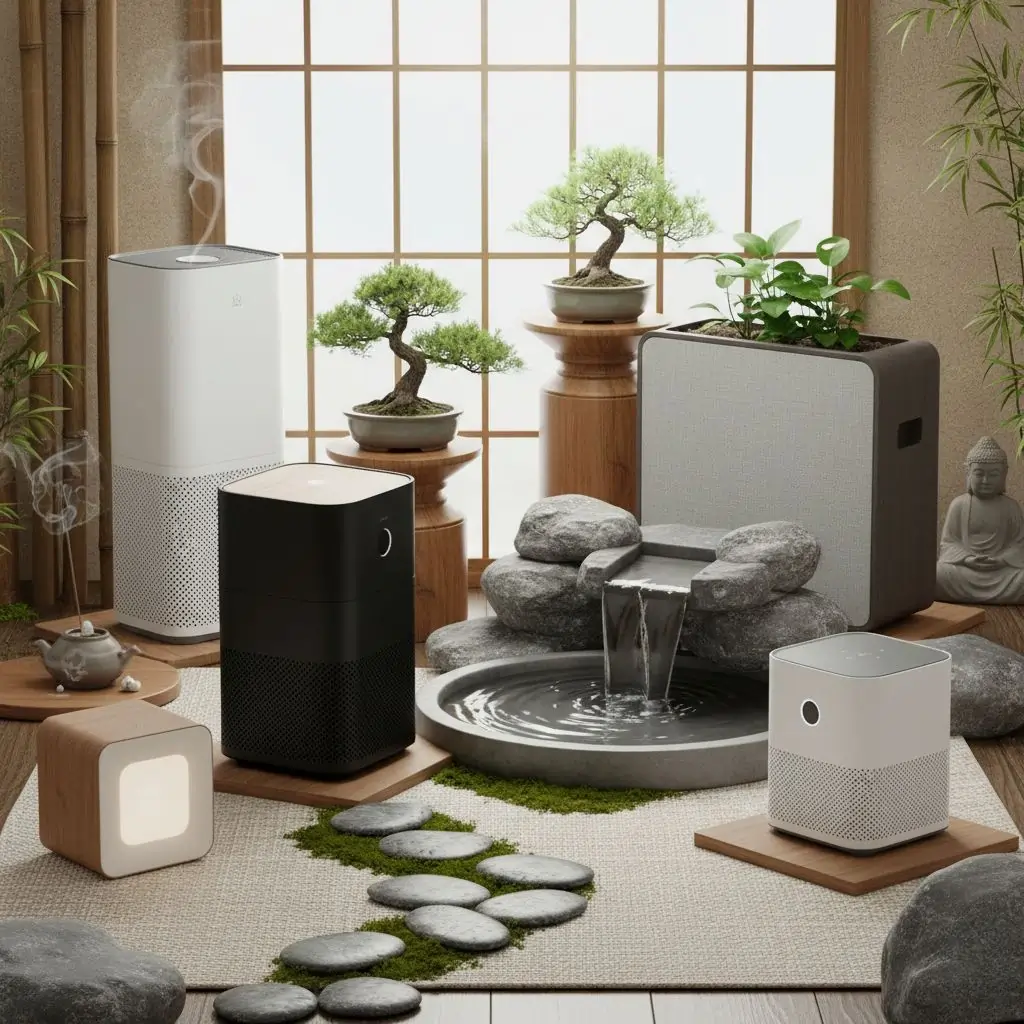
There are a ton of air purifiers out there, but only a few can actually handle tough smells in your home. Picking the right one isn’t as simple as grabbing the first model you see online. Odds are, if you don’t pay attention to what goes inside the machine, you’ll end up disappointed.
Importance of Activated Carbon and Filter Media
If you’re after clean smelling air, look for activated carbon filters, nothing else matches their ability to confine odors at the source. Activated carbon (sometimes called charcoal) is great at grabbing onto tiny odor causing gases floating around. This is what aids with smells from meal preperation, smoke, pets, or chemicals. Some filters even mix in special substances (chemisorbents) to deal with tough stuff like certain VOCs from paints or cleaners.
A typical filter setup for odor control might look like this:
- Pre-Filter: Catches dust and bigger particles, helps the main filters work better and last longer.
- HEPA Filter: Grabs things like pollen or pet dander even though it’s not for odors, it assists keep air cleaner overall.
- Activated Carbon Filter: Tackles the actual smells and chemicals.
| Filter Type | Removes Particles? | Removes Smells? | Notes |
|---|---|---|---|
| Pre-Filter | Yes | No | Extends life of main filters |
| HEPA Filter | Yes (tiny stuff) | No | Not for gases/odors |
| Activated Carbon | No | Yes | Best for most household odors |
| UV-C/Ionizer | Sometimes | Sometimes | Can generate ozone |
Sometimes, a machine will claim to “remove odors” but only comes with a HEPA filter. Don’t fall for it, it’s the carbon filter you need if you’re really dealing with bad smells.
Differences in Air Purifier Designs
Shopping for machines can get confusing fast. Some air purifiers stack multiple filters together, while others utilise electric charges (like electrostatic precipitators) or even throw in UV lights. Each approach has pros and cons, but for smell control, it’s mostly about the filters.
A few things to keep in mind:
- Machines with bigger, thicker carbon filters last longer between changes and confine more odors.
- Electrostatic models might tackle basic smells but can’t manage heavy-duty chemicals or smoke the way carbon can.
- Ionizers claim to kill germs, but sometimes they generate ozone, which you probably don’t want around if you’ve got allergies or asthma.
Some brands offer add on filters for extra targeted odor control (e.g., a dedicated “smoke stop” filter for tobacco funk).
Considerations for Space Size and Odor Source
Not every air purifier is built for every room. Bigger spaces or persistent smells usually need a beefier machine, sometimes with several pounds of carbon packed inside.
Here’s what to think about before buying:
- Room size : An undersized purifier will run forever and still not fix the problem in large rooms.
- Strength of odor source : A light kitchen smell isn’t the same as several smokers or a musty basement.
- How often you want to swap filters : Larger carbon filters last longer, but usually cost more upfront.
- Noise and energy use : More powerful models can be louder or utilise more electricity but may get the job done quicker.
If you’re only dealing with mild smells in a bedroom, a compact model with a modest carbon section can work.
For lingering smoke, pet odors, or chemical fumes, go big, more carbon, more air flow, and possibly a multi-step filter design.
Watch out for ozone and other byproducts, especially if you have respiratory sensitivities.
Getting scent-free air from a purifier means knowing exactly what’s in the box and choosing based on your own particular challenges, not just flashy marketing.
Maximizing Odor Removal Efficiency With Air Purifiers
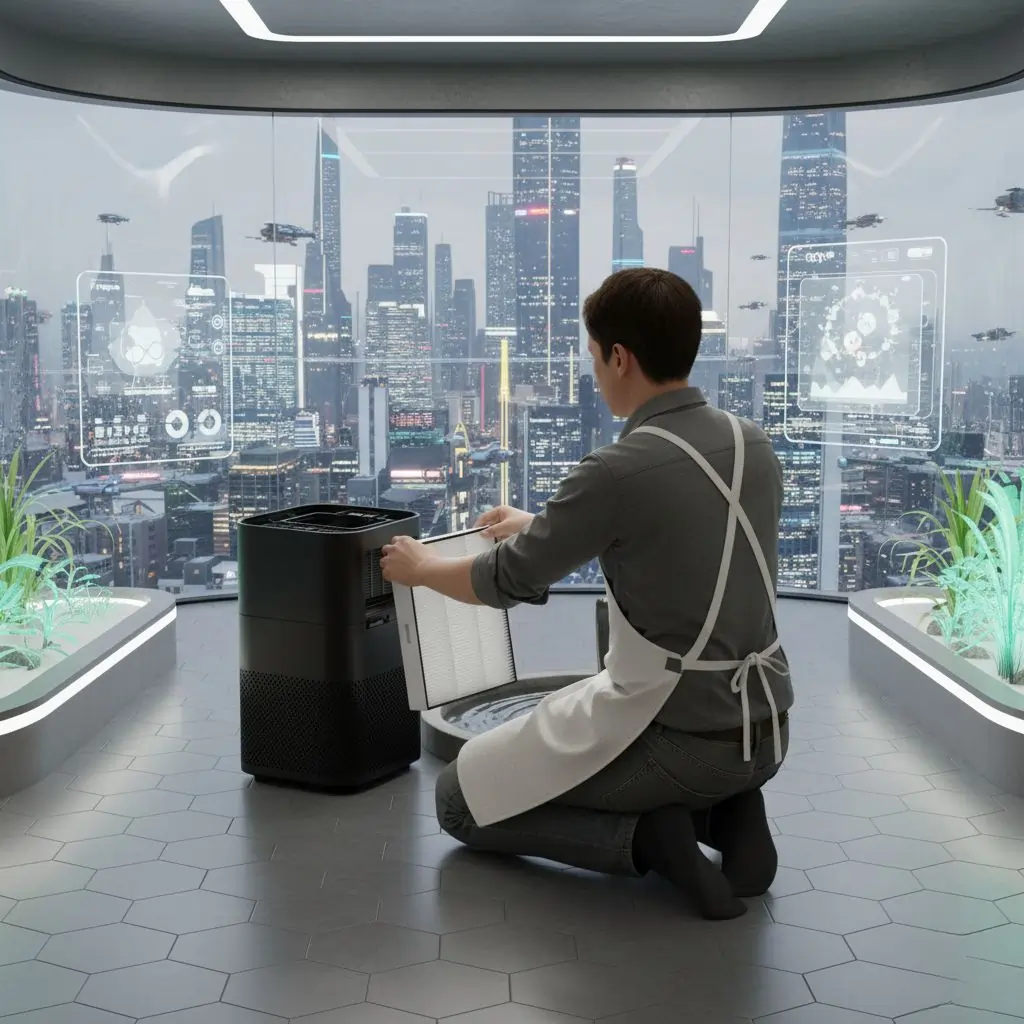
Getting rid of stubborn smells with your air purifier isn’t just about hitting a button and walking away. Air purifiers are sensitive to how you utilise and care for them, and just a couple of changes in how you treat these machines can make a big difference in your house’s air. Let’s look at a few straightforward strategies to assist your purifier to work harder for you and to keep your living spaces fresher for longer.
Proper Maintenance and Filter Replacement
Filter replacement is the most critical step for keeping odor removal strong. Filters that get clogged with dust, dander, and confined gases can’t do their job. Here’s how to keep your machine running right:
- Change activated carbon and HEPA filters as recommended (usually every 6–12 months for carbon).
- Clean pre-filters every month or two if they’re washable, so the main filter doesn’t get overloaded.
- Watch for changes in smell, air quality, or noises from your device, these are all signs it may need servicing or a new filter.
- Ignore filter changes, and your air purifier won’t just stop fighting odor, it might start recirculating musty smells.
Optimal Placement in the Home
Where you set up your air purifier really matters. If it’s tucked behind a sofa or stuck in the far corner, most of your air won’t even pass through it. To boost smell removal:
- Place the unit near odor sources (kitchen, litter box, shoe racks).
- Avoid shoving it against the wall or furniture, leave a couple of feet around each side.
Try the main living areas or entryways for general odor coverage, but move it to problem spots after cooking, cleaning, or if pets make a mess.
Complementary Method: Ventilation and Cleaning
Air purifiers aid you a lot, but they aren’t miracle workers. Sometimes smells are just too intense or stuck for any filter alone. To really freshen up:
- Open windows and doors for 10–15 minutes daily to let new air in.
- Clean and remove sources of stink (like trash, dirty laundry, or litter boxes) often.
- Use deodorizers or baking soda for areas that hold onto smells, especially carpets and upholstery.
If you match your air purifier with these good habits, you’ll notice your home keeps that clean smell for much longer. There’s no single answer to indoor odors, but treating your purifier like a team player makes a real impact.
Comparing Popular Air Purifiers That Target Smells
When you’re thinking about an air purifier for odors, the choices can honestly get a bit overwhelming. Not all brands are great at handling smells, especially persistent ones like smoke or pet odors. Below, we’ll look at a few well-known options each one stands out for different reasons. Some push performance, while others keep things easy on the wallet. Here’s the breakdown:
Blueair and Specialized Gas Filters
- Blueair air purifiers have gotten a lot of attention for their odor busting filters. They offer optional SmokeStop or particle and gas filters, making them a solid pick for people dealing with smoke, kitchen smells, or musty odors.
- Their filters use a combination of activated carbon and special media to trap gases and odors rather than just trapping dust. Blueair models are known for quiet operation, energy-saving features, and not creating ozone as a byproduct.
- The easy to replace filters are a real bonus, especially if you hate fiddly maintenance. They aren’t always the cheapest, but they’re reliable for targeted smell control.

– Perfect For Large Rooms
– 4 Layers Of Filtration
– Customisable
– Mobile App Friendly

– Perfect For Large Rooms
– Very Quite On Low Speed
– Low Electric Consumption
– Mobile App Friendly
IQAir and High-Capacity Carbon Units
If you have a big space or struggle with persistent smells, IQAir is in a class of its own. These machines pack pounds of activated carbon some models close to 5 pounds per unit.
IQAir’s HealthPro series can handle tough stuff: smoke from cooking, tobacco, renovation fumes, and even VOCs from new paint or furniture.
Yes, they are expensive, but each unit gets individually tested in Switzerland for quality and airflow.
Here are a few things you get with IQAir:
- Massive filter media for longer lasting use between changes
- Robust build, often used in hospitals and clinics
- Absolute top tier filtration for both particles and gases

– Advanced 7 Stage Filter
– Perfect For Large Rooms
– 99.5% Filter Efficiency
– Mobile App Friendly
For families sensitive to air quality or anyone tired of lingering smoke or mustiness, IQAir can honestly feel like breathing fresh outdoor air inside.
Levoit and Budget Friendly Odor Solutions
Not everyone wants to drop hundreds of bucks on a purifier, and that’s where Levoit shines. The Core 300 model, for example, is usually under $100 and uses pelleted carbon in its filters, which actually does a decent job with mild smells.
Levoit units are straightforward few bells and whistles, but they work well for smaller rooms or apartments.
Maintenance is cheap, filters are easy to swap, and they’re super portable.
A few reasons people pick Levoit:
- Affordable pricing
- Compact size
- Removes basic cooking and pet odors
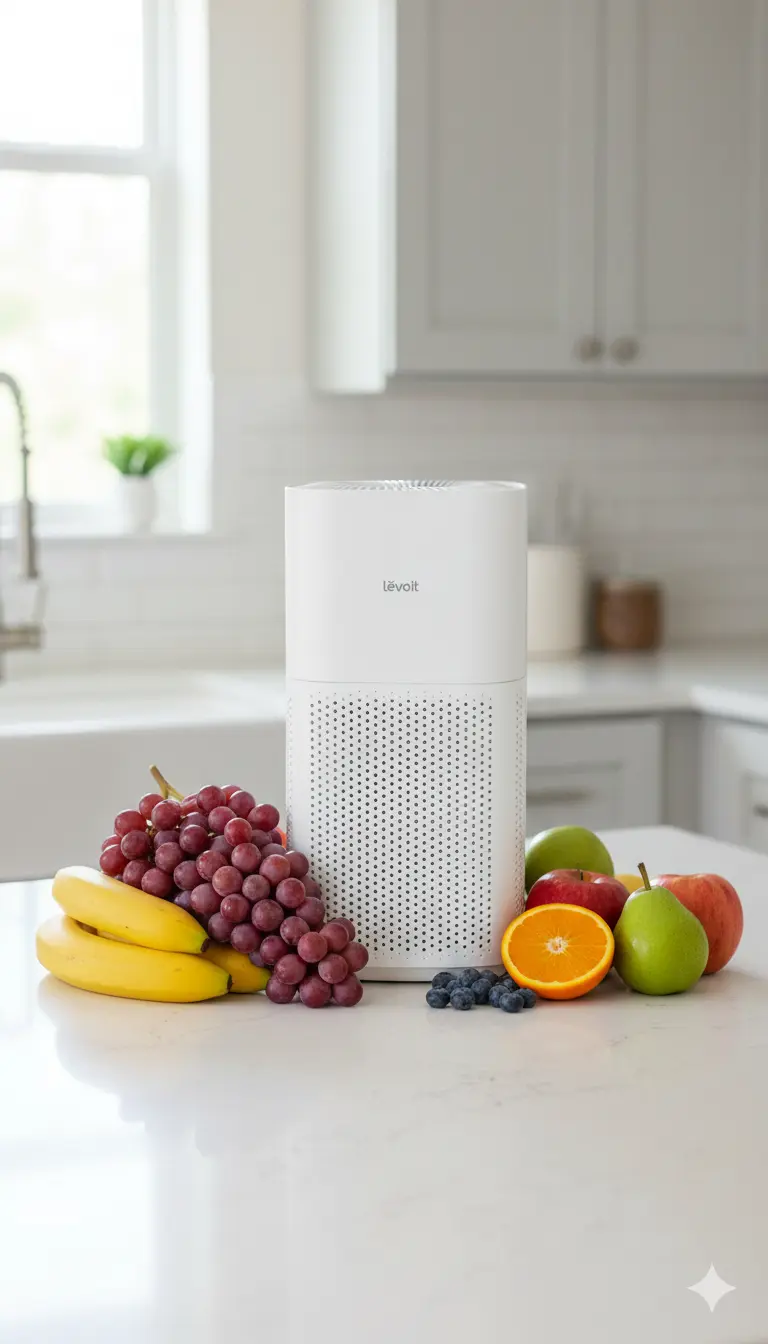
– AHAM Approved
– Color Options Available
– High Performance Capacity
– Mobile App Friendly
When you’re picking an air purifier, think about the size of your space, what kinds of odors bother you most, and how much you really want to spend. Air purifiers with activated carbon filters are your best bet for knocking out smells, but there’s a good range out there for every budget and need.
What Air Purifiers Can’t Do: Limitations With Persistent Odors
Sometimes an air purifier isn’t enough. There are some smells that just won’t budge, no matter how much you clean or run your machine. Even if you have the fanciest filter, air purifiers hit their limits with certain persistent odors, especially when it comes to deeply embedded smells or chemical residues.
Understanding Third Hand Smoke Challenges
Third hand smoke is incredibly stubborn and tough for any home device to handle. While most air purifiers with activated carbon can break down or absorb cigarette smoke odors, third hand smoke is different. This type of residue clings to walls, curtains, carpet, and even your furniture. Since it’s stuck to surfaces, not floating in the air, standard purifiers can’t pull it in, no matter how long you run them. Plus, the chemicals in third hand smoke can linger for months or even years after smoking stops.
- Third-hand smoke settles into materials, beyond the reach of air filters.
- Regular filter maintenance won’t affect these lingering toxins.
- Professional cleaning or removing contaminated items is usually necessary.
If you’ve quit smoking or moved into a place with a smoke history, don’t expect any air purifier to erase those stubborn signs, sometimes the only fix is deep cleaning or even repainting.
When to Avoid Ozone Generators
Ozone generators might sound like a big solution for strong smells, but they can create more problems than they solve. These machines function by generating ozone gas (O₃), which reacts with other chemicals to break down odors. The problem? Ozone itself is a lung irritant and can pose health risks, especially to kids, older adults, and those with asthma.
Here’s why ozone generators aren’t a good idea for home use:
- Ozone can trigger respiratory issues.
- They may not eliminate the source of stubborn odors.
- The EPA warns against using ozone generators in occupied spaces.
For truly clean air, safer options include using filters with activated carbon or even opening windows for fresh air instead of relying on ozone generators. For more on this, see options for persistent allergy symptoms and lingering odors.
Setting Realistic Expectations for Air Purifier Performance
Even with a great air purifier, some odors just need more help. Air purifiers can make a noticeable impact on smells like cooking, pets, and light smoke, but they can’t remove everything.
A few things to remember:
- Filters must be replaced on schedule to performa gainst ongoing smells.
- Persistent or mysterious odors often need direct cleaning of fabrics, carpets, or wall surfaces.
- Some sources like mold, sewer gases, or harsh chemicals, require fixing leaks or professional help before air quality improves.
Air purifiers are great tools for fresher, safer air, but they’re not magic. Their impact depends on the odor source, room size, filter type, and how often maintenance is done. For stubborn smells, combining multiple strategies is key.
Conclusion
So, do air purifiers help with smell? The short answer is yes, but it depends on the type of purifier and what you’re trying to get rid of. If you’re dealing with cooking odors, pet smells, or even smoke, a purifier with an activated carbon filter can make a real difference.
Just keep in mind, not every air purifier is built for this job, HEPA filters are great for dust and allergens, but they don’t do much for smells on their own. Activated carbon is the real hero when it comes to odors. Still, an air purifier isn’t a magic fix. You’ll get the best results if you use it along with regular cleaning and good ventilation. At the end of the day, an air purifier can help your home smell fresher, but it functions best as part of a bigger routine to keep your air clean.

